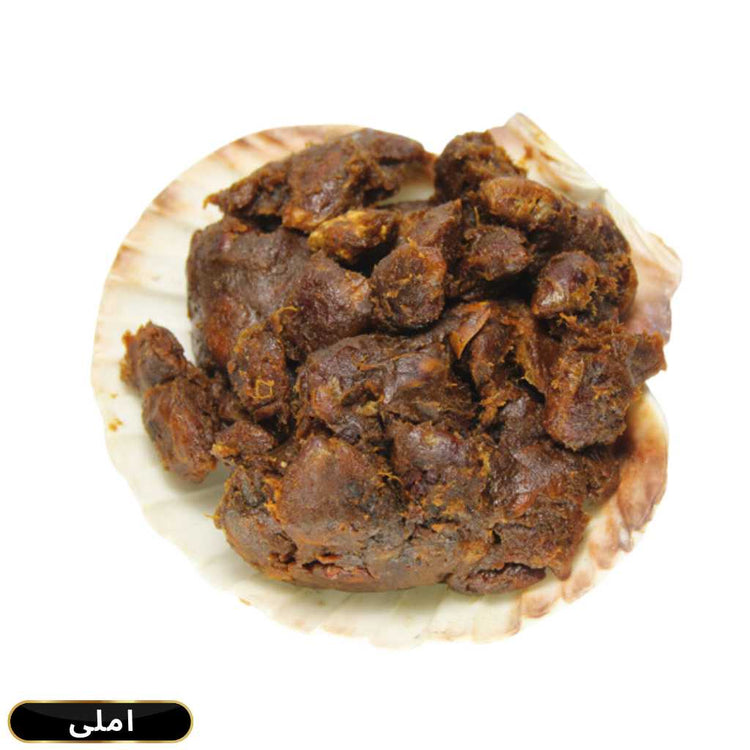
Fresh Tamarind fresh Imli 100gm Packs
Availability: In Stock
SKU:
AR-000141








Tamarind, known for its distinctive sweet and tangy flavor, is a popular ingredient in Pakistani cuisine. The price of tamarind in Pakistan can vary based on several factors, including quality, season, and location. On average, tamarind is priced between PKR 200 to PKR 400 per kilogram in the local market. However, prices may fluctuate slightly depending on market conditions and availability.
Quality: The quality of tamarind can significantly impact its price. Tamarind that is fresh, well-preserved, and free from any impurities or contaminants is generally considered to be of higher quality and may be priced slightly higher.
Season: Tamarind availability and pricing can be influenced by the season. The peak season for tamarind in Pakistan is typically during the summer and monsoon months, when the fruits ripen and are harvested. During this time, tamarind is more abundant, and prices may be relatively lower compared to other seasons.
Location: Tamarind prices can vary slightly depending on the location of purchase. Factors such as transportation costs and local demand can influence pricing variations between different regions in Pakistan.
When it comes to online purchasing, Khan Dry Fruit is a reputable platform that offers a convenient option for buying tamarind and other quality products. As a trusted online supplier, Khan Dry Fruit provides a wide range of spices, including tamarind, ensuring convenience and reliability for customers.
By visiting the Khan Dry Fruit website, customers can explore the available options, compare prices, and make a purchase with ease. The platform offers a seamless online shopping experience, providing access to high-quality tamarind and reliable delivery services.
It is worth mentioning that while online platforms like Khan Dry Fruit offer convenience, it is important to ensure the credibility of the source to guarantee the quality and authenticity of the product. Khan Dry Fruit is known for its commitment to providing quality products, making it a reliable choice for online tamarind purchases.
In conclusion, the price of tamarind in Pakistan can vary based on factors such as quality, season, and location. Khan Dry Fruit offers a reliable online platform for purchasing tamarind, ensuring convenience and access to high-quality products. It is always recommended to compare prices and ensure the credibility of the source before making a purchase, whether online or from local markets.
Tamarind: A Unique Sweet and Tangy Fruit with Versatile Culinary Uses
Tamarind, scientifically known as Tamarindus indica, is a tropical fruit that is widely recognized for its distinctive sweet and tangy flavor. It is native to Africa but is now cultivated in many parts of the world, including Asia, Latin America, and the Caribbean. The tamarind tree produces brown, pod-like fruits that contain a pulp with a fibrous texture and a rich, tart taste. In this article, we will explore the history, cultivation, culinary uses, nutritional value, and potential health benefits of tamarind.
History and Cultivation
Tamarind has a long history of use in traditional medicine and cuisine. It has been consumed for centuries in various cultures and has found its way into many traditional recipes. The exact origin of tamarind is not well-documented, but it is believed to have originated in tropical Africa and then spread to other parts of the world through trade and exploration.
The tamarind tree is an evergreen tree that can grow up to 25 meters tall. It has a dense canopy of feathery leaves and produces small, fragrant flowers that develop into the fruit pods. The pods, which are approximately 5-15 centimeters in length, contain a sticky pulp that surrounds the seeds. The pulp is the main edible part of the fruit and is widely used for its flavor and culinary properties.
Culinary Uses
In terms of culinary uses, tamarind is a versatile ingredient that adds a unique flavor to a wide range of dishes. It is commonly used as a souring agent in savory dishes, such as curries, soups, and sauces. The pulp can be extracted by soaking it in water and then straining it to remove the fibers and seeds. Tamarind paste or concentrate is a popular form of tamarind used in cooking. It is known for its ability to add a tangy and slightly sweet taste to dishes, balancing out flavors and enhancing the overall taste profile. Tamarind is also a key ingredient in various chutneys, marinades, and beverages, including tamarind-based drinks and desserts.
Nutritional Value
In addition to its culinary uses, tamarind also offers several potential health benefits. It is a good source of antioxidants, including vitamin C and various phenolic compounds, which help protect the body against damage caused by free radicals. Tamarind also contains fiber, which aids in digestion and can help promote regular bowel movements. The fruit is also a natural source of tartaric acid, which has been shown to have antimicrobial properties.
Tamarind is also rich in various vitamins and minerals, including potassium, magnesium, and iron. These nutrients play important roles in maintaining overall health and well-being. Additionally, tamarind has been traditionally used in herbal medicine for its potential anti-inflammatory properties and as a remedy for digestive disorders.
Health Benefits and Safety
When consumed in moderation as part of a balanced diet, tamarind is generally safe for most people. However, individuals with certain medical conditions or who are taking specific medications should consult with a healthcare professional before consuming tamarind or its extracts.
Conclusion
In conclusion, tamarind is a tropical fruit that is prized for its unique sweet and tangy flavor. It has a rich history of culinary and medicinal use and is appreciated for its versatility in various dishes. With its potential health benefits and distinct taste, tamarind continues to be a popular ingredient in many cuisines around the world.
Tamarind: A Unique Sweet and Tangy Fruit with Versatile Culinary Uses
History and Cultivation
Tamarind, scientifically known as Tamarindus indica, has a long history of use in traditional medicine and cuisine. Its origins can be traced back to tropical Africa, from where it spread to other regions across the globe. The tamarind tree is an evergreen tree that can reach impressive heights of up to 25 meters. It features a dense canopy of feathery leaves and produces small, fragrant flowers that eventually develop into the distinctive brown, pod-like fruits.
Culinary Uses
Tamarind's sweet and tangy flavor makes it a popular ingredient in various culinary creations. The pulp derived from tamarind pods is often used as a souring agent in a wide range of savory dishes. It adds a delightful tartness and slight sweetness to curries, soups, sauces, and stews. Tamarind paste or concentrate, which is extracted by soaking the pulp in water and straining it, is a convenient form widely used in cooking. The unique flavor of tamarind is also prominent in chutneys, marinades, refreshing beverages, and delectable desserts.
Nutritional Value and Health Benefits
Tamarind not only enhances the taste of dishes but also offers several potential health benefits. It is a rich source of antioxidants, including vitamin C and various phenolic compounds, which help protect the body against harmful free radicals. The fiber content in tamarind supports healthy digestion, aids in regular bowel movements, and may contribute to weight management. Additionally, tamarind is known to contain minerals such as potassium, magnesium, and iron, which are essential for maintaining overall health.
The antimicrobial properties of tamarind have been studied, suggesting potential benefits in fighting against certain harmful microorganisms. Traditional medicine has utilized tamarind for its potential anti-inflammatory effects, which may help reduce inflammation in the body. However, further scientific research is required to fully understand and confirm these properties.
Safety Considerations
Tamarind is generally safe for consumption as part of a balanced diet. However, it is important to note that individuals with specific medical conditions or those taking certain medications should consult with a healthcare professional before incorporating tamarind into their diet.
Conclusion
Tamarind, with its unique sweet and tangy flavor, adds a distinctive touch to various culinary creations. Its versatile applications, ranging from savory dishes to delightful desserts, have made it a beloved ingredient in cuisines around the world. With its potential health benefits and rich cultural history, tamarind continues to be cherished as a flavorful and versatile fruit.
How to Use Tamarind: Adding Tangy Flavor to Your Dishes
Tamarind, with its distinct sweet and tangy taste, is a versatile ingredient that can enhance the flavor of various dishes. Here are some popular ways to use tamarind:
Tamarind Paste: Tamarind paste is a common form of tamarind used in cooking. To make tamarind paste, soak tamarind pulp in warm water for about 15-20 minutes. Squeeze and strain the pulp to remove the seeds and fibers, resulting in a thick, tangy paste. Use this paste as a base for sauces, curries, and chutneys.
Tamarind Juice: Tamarind juice is a refreshing beverage enjoyed in many cultures. Soak tamarind pulp in water and let it sit for a while. Then, squeeze the pulp to extract the juice. Add sugar or honey to sweeten it, and serve chilled with ice for a tangy and revitalizing drink.
Tamarind in Curries and Stews: Tamarind adds a delightful tanginess to curries and stews. Simply dissolve tamarind paste in warm water and add it to your curry or stew during the cooking process. It will infuse your dish with a unique flavor and balance out the other ingredients.
Tamarind in Chutneys and Dips: Tamarind chutney is a popular condiment that complements snacks and appetizers. To make tamarind chutney, combine tamarind paste with sugar or jaggery, along with spices like cumin, ginger, and chili powder. Adjust the sweetness and spiciness to your liking, and serve it as a dipping sauce or accompaniment to samosas, pakoras, or chaat.
Tamarind in Marinades and Glazes: Tamarind can be used to make flavorful marinades and glazes for meats, seafood, and vegetables. Mix tamarind paste with spices, herbs, and other ingredients like soy sauce, garlic, and ginger to create a tangy and savory marinade. Let your ingredients marinate for a while to allow the flavors to meld together before cooking.
Tamarind in Dressings and Sauces: Tamarind can be incorporated into dressings and sauces to add a tangy kick. Combine tamarind paste with ingredients like vinegar, oil, honey, and spices to create delicious salad dressings or tangy barbecue sauces.
Remember to taste as you go when using tamarind, as its tanginess can vary. Adjust the amount of tamarind paste or juice according to your preference, and balance it with other flavors like sweetness or spiciness. With its unique flavor, tamarind can elevate your dishes and bring a delightful tang to your culinary creations.